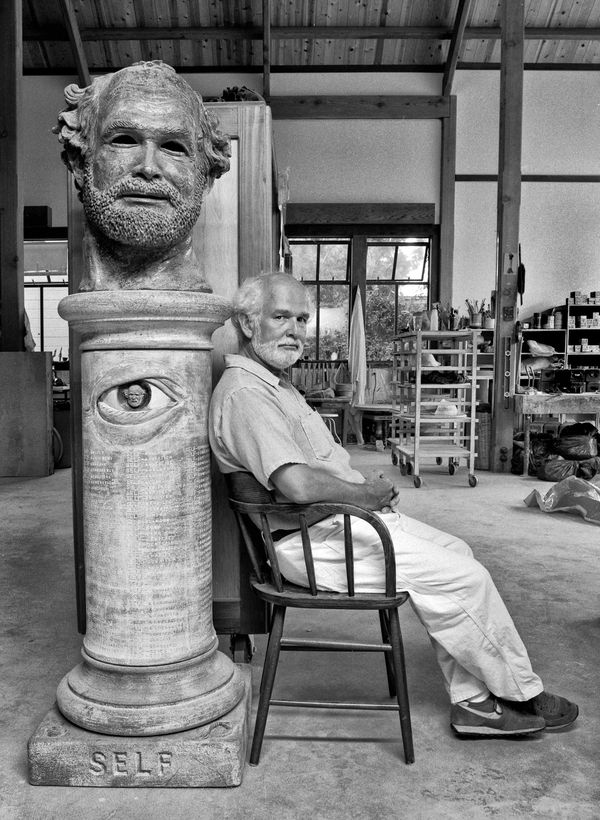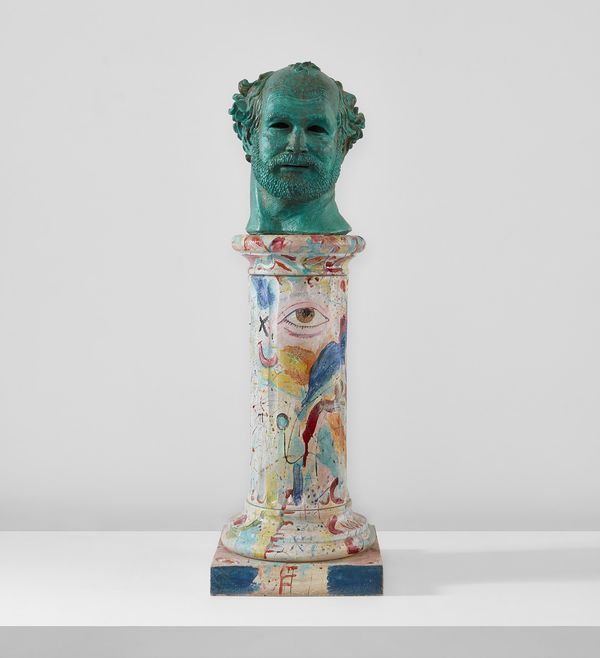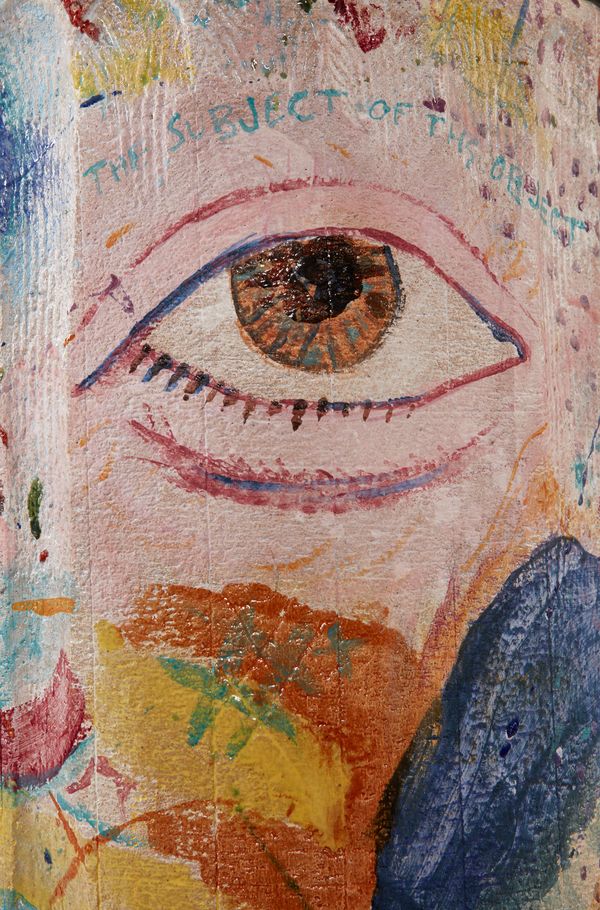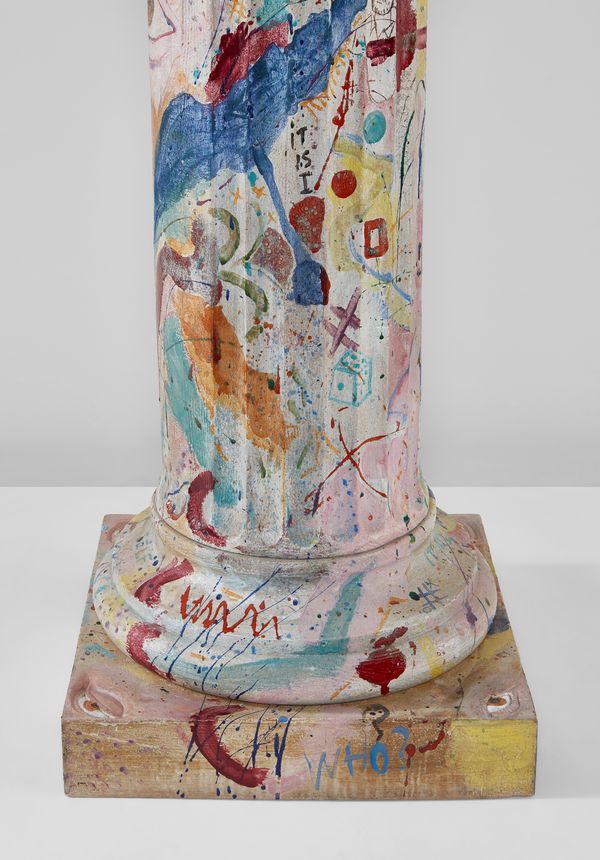Robert Arneson with another version of ‘This Head is Mine’ in his 430 First St. studio located in Benicia, California, 1985. Artwork © 2018 Estate of Robert Arneson / Licensed by VAGA at Artists Rights Society (ARS), NY. Photograph by Kurt Edward Fishback ©1985
By Glenn Adamson
1981: the birth of a decade. In that year, MTV launched. So did the Memphis design collective. The first personal computers were sold, and the word “internet” entered the English language. And what was Robert Arneson doing? Finishing up work on a classical bronze bust, sitting on a column-shaped plinth. It was entirely typical of this master contrarian. From the outset of his career, he swam against the tide and accepted his fate as a ceramicist (then a mostly unfashionable discipline) with mordant wit. Ceramics, he pointed out facetiously, was always stuck in the art school basement. It was “the world’s most fascinating hobby.”
A breakthrough came in 1961 when he was sitting bored at a Northern California craft fair. A potter named Fred Ball, just a teenager at the time, later described what happened: “I sat in back of Arneson, who was throwing a squat bottle; he slashed an ‘x x x’ across it, sliced the outline of a label, thumbed a piece of clay into a pop-top shape, and presto: a big clay beer bottle came out of a weed pot.”1 Arneson then added a label in little clay coils: NO DEPOSIT, NO RETURN. The object was eerily in tune with Pop Art, just then being invented on the other coast. It was also prescient, for he never did look back.
Soon Arneson brought to a close his initial, fitful efforts to make expressionist sculpture in the manner of Peter Voulkos (who had just arrived in the Bay Area), and instead unleashed a torrent of raunchy hilarity. He plumbed the debased utilitarian formats of his discipline, such as bricks, flowerpots and toilets, mocking the pretensions of clay-as-art. He fooled around with surrealism, in a memorable typewriter with lacquered fingernails in the place of keys, and a toaster with sausage-like fingers waggling up out of its slots. Before long this self-appointed court jester of the craft movement found himself surrounded by disciples, particularly at the University of California at Davis, where he taught beginning in 1962 — among them Margaret Dodd, David Gilhooly, Chris Unterseher and Peter Vandenberge. Bruce Nauman was there too, conducting his first performance art pieces.
Arneson and his adherents were claimed for “Funk Art” by curator Peter Selz, in an influential show of that title held in 1967. Most of them shrugged — call us whatever you want — and the label stuck. Arneson pressed on, creating increasingly ambitious work, less concerned with his medium and more with his psyche. One series, begun in 1966, dwelled on the suburban mundanity of his own home on Alice Street, which he described as follows: "a slab-floor, one- story, three-bedroom, two-bath, two-car garage, California-style house. It is for sale.”2 Another consisted of trophies whose sad-sack silhouettes made them seem like awards for last place.
Robert Arneson This Head is Mine, 1980-81. This work will be featured in Shape & Space: A New Ceramic Presence, a special Evening Sale on 5 October 2018 in London.
Then there were self-portrait busts, in seemingly endless variety. The very first one cracked in the kiln, offering Arneson the opportunity to make a joke at his own expense: Self-Portrait of the Artist Losing His Marbles (1965). In A Hollow Jesture (1971 – note the spelling), he sticks out his tongue at anyone who happens by. This spate of self-satire arguably peaked with Smorgi- Bob the Cook (also 1971), a massive installation in white low-fire clay, the medium of choice for beginners. In it, Arneson adopts the guise of a ceramic Julia Child, an avalanche of handmade footstuffs cascading down a slanted table in front of him; he later remarked that he'd intended to "china paint it all like I was doing the dirty dishes," but an exhibition came along and he never quite got round to it.3
Over the following decade, Arneson continued to create self-portraits, drawn as well as sculpted. (As Ball put it in 1973, “Arneson’s theme is now Arneson.”)4 He began exploring the format of the sculptural bust in greater depth, showing no less than eighteen simultaneously in a show at his regular gallery, Hansen-Fuller. Deeper, too, was the emotional and narrative sophistication of the work. In addition to his stream of self-portraits, he portrayed other prominent artists past and present, among them his colleagues Peter Voulkos and David Gilhooly, as well as Pablo Picasso and Francis Bacon. Jackson Pollock was to become a particular object of fascination, perhaps because the Abstract Expressionist’s confident gestures and reckless machismo represented all that Arneson could not lay claim to. He was cursed with self- awareness.
In works like 'This Head is Mine', Arneson achieved a quality of philosophical introspection that is rare in any art form.
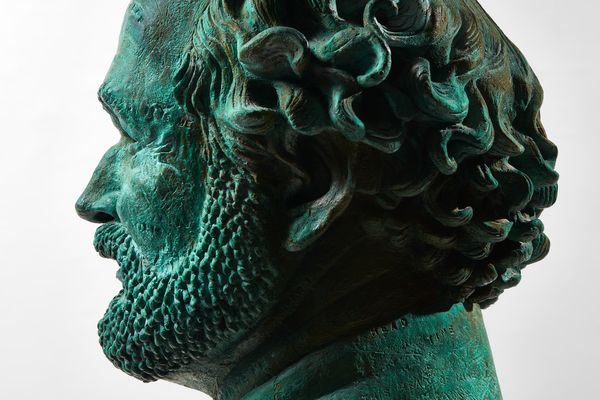
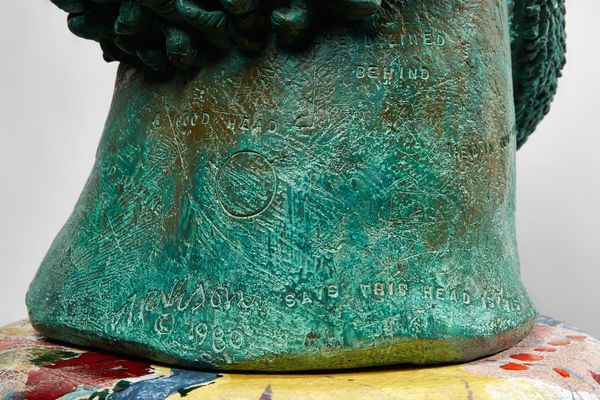
In 1981 he had a brush with serious controversy: he had been awarded a commission to depict George Moscone, the mayor of San Francisco, who had been assassinated by a mentally ill former city employee. Gay activist Harvey Milk lost his life in the same tragic incident. Arneson misjudged the moment but made a savagely great work in the process. He brought his customary irony to the project: a grinning Moscone, unsuspecting, atop a pedestal riddled with bullet holes and scrawled with text. “Smith and Wesson” (the murder weapon). “Twinkies” (The murderer infamously blamed his addiction to junk food for his crime). “Harvey Milk, too.”
The rawness of the work endures better than most monuments to tragedy, which pale into anodyne irrelevance over time. When you look at Arneson’s response to Moscone, you can still feel the shock and senselessness of the tragedy. If anything, the work feels more relevant with passing years; it’s a genuinely human response to gun violence. But at the time, it brought him nothing but trouble. After much complaint, the commission was rejected and returned to the artist. It’s now in the collection of the San Francisco Museum of Modern Art, whose curator Gary Garrels comments that the work’s reception prompted Arneson to “think increasingly in terms of moral responsibility and political commitment as primary to his choice and treatment of subjects.”5
Perhaps we should see Arneson’s This Head Is Mine in light of this change. Executed in the same year and in the same format as the Moscone portrait, it also shares with the controversial work a sense of fallen heroism. Much of this has to do with the selection of materials. Instead of Arneson’s usual ceramic, the self-portrait head is rendered in cast bronze, that most elevated of artistic media. He exploited the potential of casting to realize multiple copies — the head exists in an edition of three, two artist’s proofs, and a foundry cast — but in an unusual move, placed it on a unique ceramic plinth, one of at least three different designs that Arneson paired with the same head.6 This complicated production history adds depth to the sculpture’s primary message: that Arneson was of a man of parts, divided against himself.
The idea is furthered by fragments of text impressed into the skin of the bust, which annotate its various features using purposefully lame puns: “it is eye,” “a time for head.” A further sketchy self-portrait appears on the columnar support, almost lost within the matrix of Pollock- like brushstrokes and proliferating eyes. These allude to Arneson’s old preoccupation, the Surrealists. The eye in isolation was central to the oeuvres of René Magritte, Salvador Dalí and Luis Bunuel, all of whom exploited the idea that it was a portal to the dreaming mind, and also a body part of unusual sensitivity and fragility. (Recall, if you can bear it, the famous opening shot of Bunuel’s film Un Chien Andalou.) Yet Arneson’s mobilization of this motif also has a more personal quality, lending the work an air of incessant self-observation.
After 1981, Arneson would continue to explore the themes in This Head Is Mine for the decade remaining to him, as well as the combination of a bronze multiple on a unique ceramic plinth. The eye motif pops up (literally) in Self, in which a mini-Arneson pokes his head out of an eyeball, like a sailor out of a porthole. In Rooted (1983, now in the collection of the Arizona State University Art Museum), he again appears doubled, both as a bronze bust and a naked, splayed-out painted figure. The composition of the latter plays on Leonardo’s Vitruvian Man, another favorite Arneson reference, playing up the famous image’s latent comedy and vulnerability. He even managed to retain this wry self-deprecation in a series of works dealing with his own battle with cancer. In these so-called Chemo Portraits (1992), the artist seems to dissolve, exposing the cavities within.
These late works are a fitting close to the arc begun in his first “cracked” self-portrait: a career’s worth of unflinching exploration. Arneson knew well the absurdity of making monuments to himself. He did it anyway. And more than that: in works like This Head is Mine, he achieved a quality of philosophical introspection that is rare in any art form. Not bad for the world’s most fascinating hobby.
This Head is Mine will be featured in Shape & Space: A New Ceramic Presence, the first international auction of its kind to focus specifically on ceramic works by renowned modern and contemporary artists
1 Fred Ball, “Arneson,” Craft Horizons 34/1 (Feb. 1974), p. 29-30. 2 Quoted in David Zack, “The Ceramics of Robert Arneson: A Plumber’s Nightmare and a Psychiatrist’s Holiday,” Craft Horizons 30/1 (Jan./Feb. 1970), p. 60. 3 Oral history interview with Robert Arneson, August 14-15, 1981. Archives of American Art, Smithsonian Institution. 4 Ball, “Arneson,” p. 65. See also Jonathan Fineberg, A Troublesome Subject: The Art of Robert Arneson (Berkeley: University of California Press, 2013). 5 Quoted in “SFMoMA Acquires Arneson’s Famous Bust of George Moscone,” press release, May 31, 2012. 6 According to the gallerist George Adams, who jointly represents the artist’s estate with Brian Gross, the original ceramic head used as the basis for the bronze edition also has a unique ceramic pedestal; this work is currently in a private collection in Des Moines, Iowa. The estate also retains another unique ceramic base for one of the heads, comparable with This Head is Mine. The pedestal for the first, ceramic head was also used as the basis for a further bronze edition of plinths – three, plus one foundry cast – with the title Myself & I. A smaller bronze sculpture from the same series, though executed in 1991, is in the permanent collection of the Seattle Art Museum. My thanks to Adams for this information.
